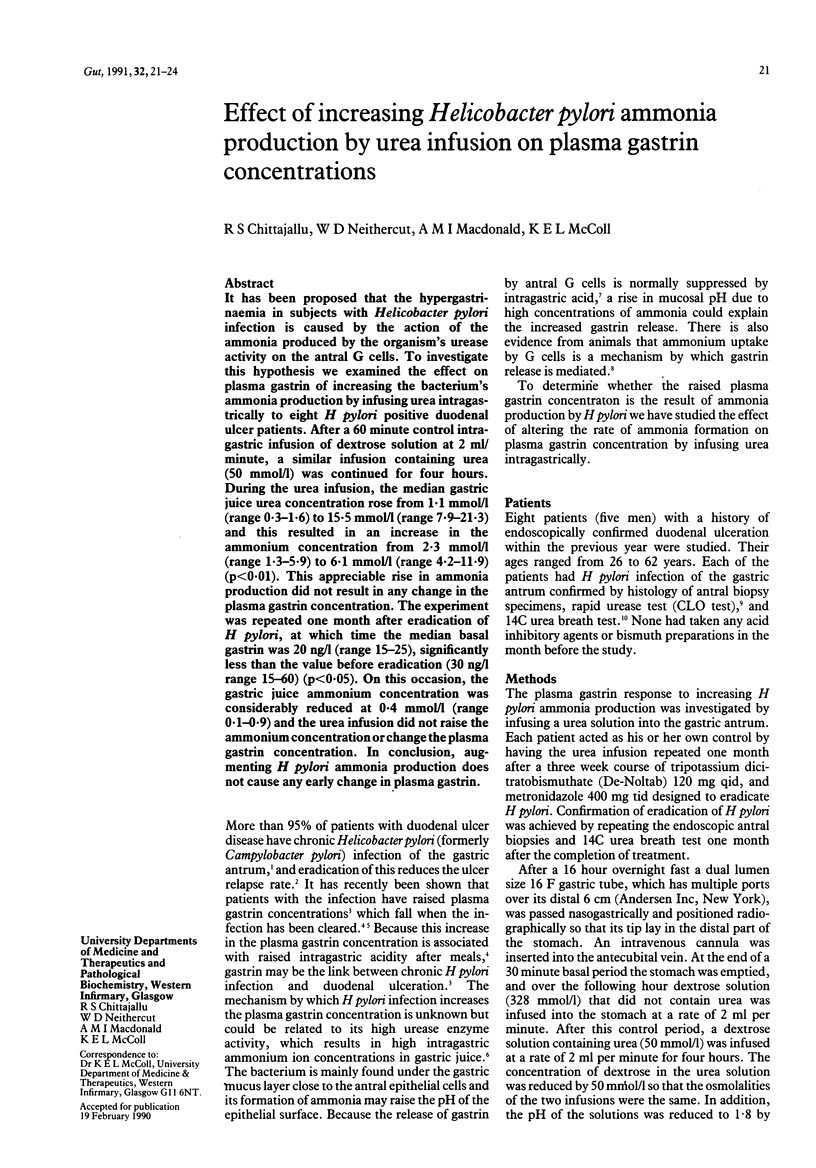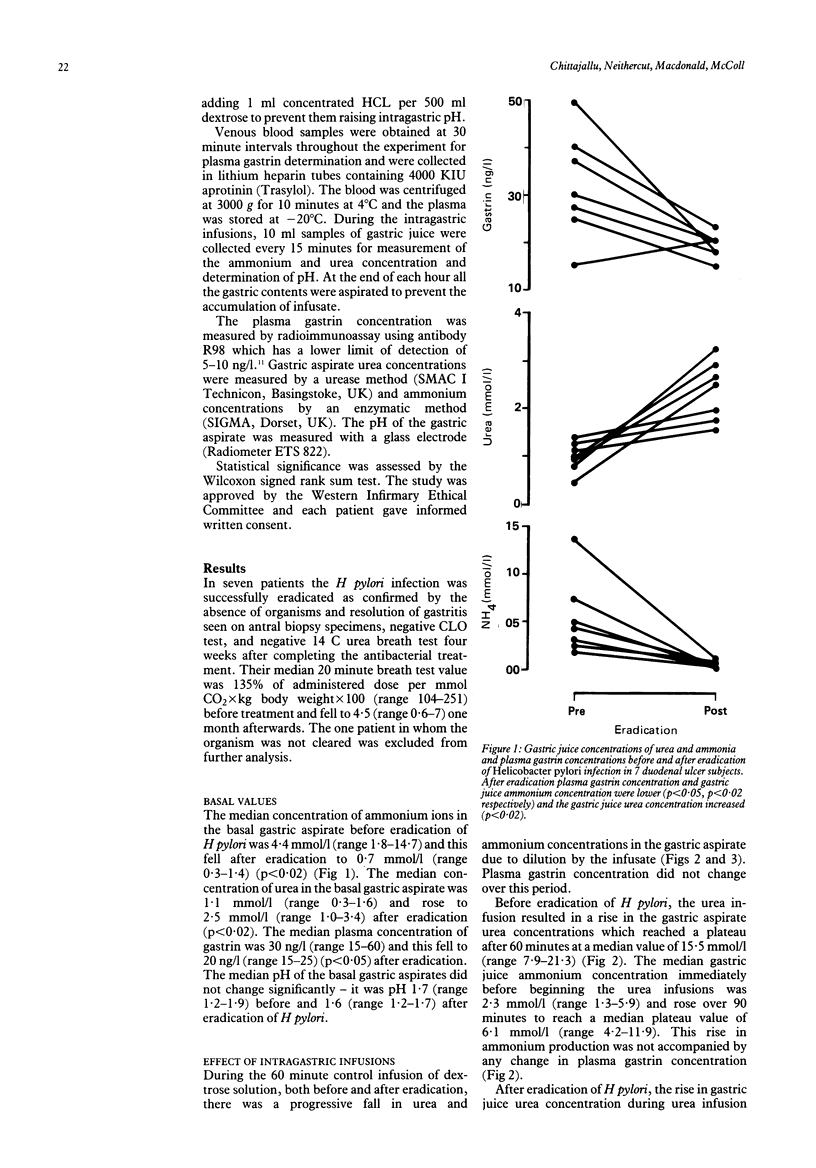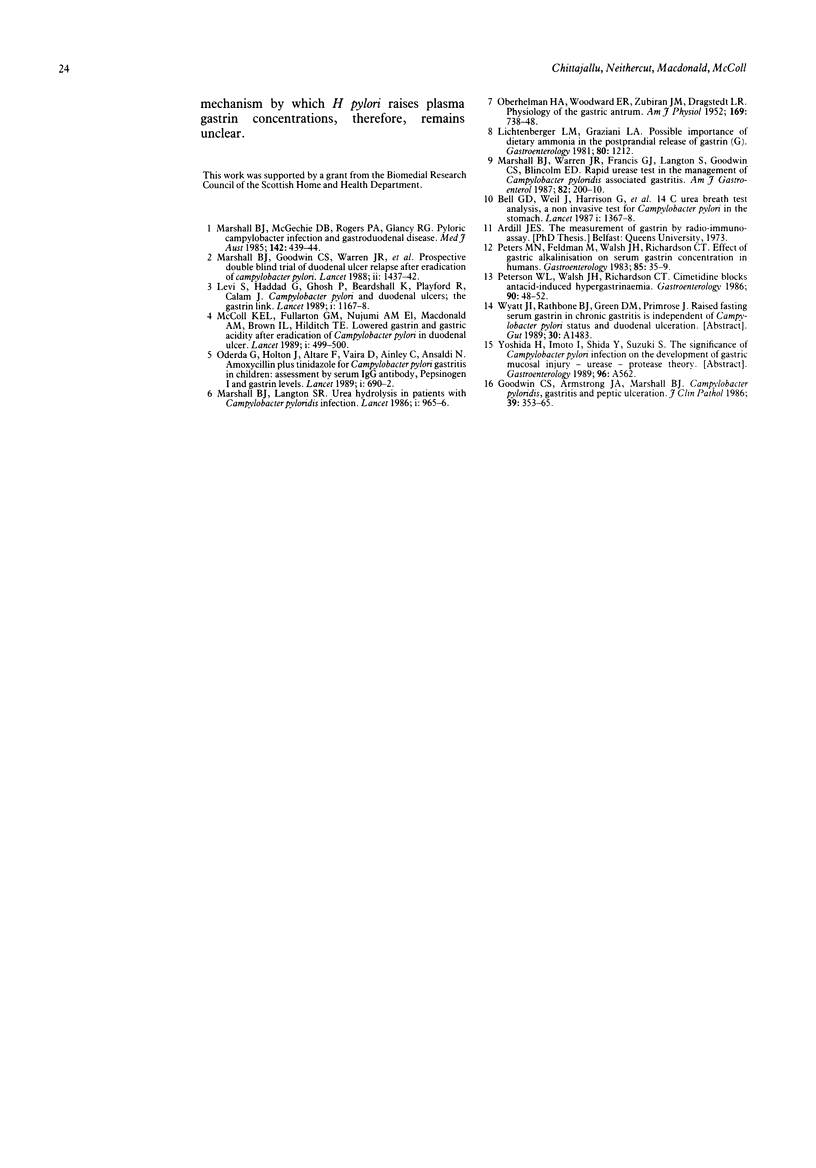Abstract
It has been proposed that the hypergastrinaemia in subjects with Helicobacter pylori infection is caused by the action of the ammonia produced by the organism's urease activity on the antral G cells. To investigate this hypothesis we examined the effect on plasma gastrin of increasing the bacterium's ammonia production by infusing urea intragastrically to eight H pylori positive duodenal ulcer patients. After a 60 minute control intragastric infusion of dextrose solution at 2 ml/minute, a similar infusion containing urea (50 mmol/l) was continued for four hours. During the urea infusion, the median gastric juice urea concentration rose from 1.1 mmol/l (range 0.3-1.6) to 15.5 mmol/l (range 7.9-21.3) and this resulted in an increase in the ammonium concentration from 2.3 mmol/l (range 1.3-5.9) to 6.1 mmol/l (range 4.2-11.9) (p less than 0.01). This appreciable rise in ammonia production did not result in any change in the plasma gastrin concentration. The experiment was repeated one month after eradication of H pylori, at which time the median basal gastrin was 20 ng/l (range 15-25), significantly less than the value before eradication (30 ng/l range 15-60) (p less than 0.05). On this occasion, the gastric juice ammonium concentration was considerably reduced at 0.4 mmol/l (range 0.1-0.9) and the urea infusion did not raise the ammonium concentration or change the plasma gastrin concentration. In conclusion, augmenting H pylori ammonia production does not cause any early change in plasma gastrin.
Full text
PDF



Selected References
These references are in PubMed. This may not be the complete list of references from this article.
- Bell G. D., Weil J., Harrison G., Morden A., Jones P. H., Gant P. W., Trowell J. E., Yoong A. K., Daneshmend T. K., Logan R. F. 14C-urea breath analysis, a non-invasive test for Campylobacter pylori in the stomach. Lancet. 1987 Jun 13;1(8546):1367–1368. doi: 10.1016/s0140-6736(87)90664-7. [DOI] [PubMed] [Google Scholar]
- Goodwin C. S., Armstrong J. A., Marshall B. J. Campylobacter pyloridis, gastritis, and peptic ulceration. J Clin Pathol. 1986 Apr;39(4):353–365. doi: 10.1136/jcp.39.4.353. [DOI] [PMC free article] [PubMed] [Google Scholar]
- Marshall B. J., Goodwin C. S., Warren J. R., Murray R., Blincow E. D., Blackbourn S. J., Phillips M., Waters T. E., Sanderson C. R. Prospective double-blind trial of duodenal ulcer relapse after eradication of Campylobacter pylori. Lancet. 1988 Dec 24;2(8626-8627):1437–1442. doi: 10.1016/s0140-6736(88)90929-4. [DOI] [PubMed] [Google Scholar]
- Marshall B. J., Langton S. R. Urea hydrolysis in patients with Campylobacter pyloridis infection. Lancet. 1986 Apr 26;1(8487):965–966. doi: 10.1016/s0140-6736(86)91060-3. [DOI] [PubMed] [Google Scholar]
- Marshall B. J., McGechie D. B., Rogers P. A., Glancy R. J. Pyloric Campylobacter infection and gastroduodenal disease. Med J Aust. 1985 Apr 15;142(8):439–444. doi: 10.5694/j.1326-5377.1985.tb113444.x. [DOI] [PubMed] [Google Scholar]
- Marshall B. J., Warren J. R., Francis G. J., Langton S. R., Goodwin C. S., Blincow E. D. Rapid urease test in the management of Campylobacter pyloridis-associated gastritis. Am J Gastroenterol. 1987 Mar;82(3):200–210. [PubMed] [Google Scholar]
- McColl K. E., Fullarton G. M., el Nujumi A. M., Macdonald A. M., Brown I. L., Hilditch T. E. Lowered gastrin and gastric acidity after eradication of Campylobacter pylori in duodenal ulcer. Lancet. 1989 Aug 26;2(8661):499–500. doi: 10.1016/s0140-6736(89)92105-3. [DOI] [PubMed] [Google Scholar]
- Multicentre randomised clinical trial of chorion villus sampling and amniocentesis. First report. Canadian Collaborative CVS-Amniocentesis Clinical Trial Group. Lancet. 1989 Jan 7;1(8628):1–6. [PubMed] [Google Scholar]
- OBERHELMAN H. A., Jr, WOODWARD E. R., ZUBIRAN J. M., DRAGSTEDT L. R. Physiology of the gastric antrum. Am J Physiol. 1952 Jun;169(3):738–748. doi: 10.1152/ajplegacy.1952.169.3.738. [DOI] [PubMed] [Google Scholar]
- Oderda G., Vaira D., Holton J., Ainley C., Altare F., Ansaldi N. Amoxycillin plus tinidazole for Campylobacter pylori gastritis in children: assessment by serum IgG antibody, pepsinogen I, and gastrin levels. Lancet. 1989 Apr 1;1(8640):690–692. doi: 10.1016/s0140-6736(89)92206-x. [DOI] [PubMed] [Google Scholar]
- Peters M. N., Feldman M., Walsh J. H., Richardson C. T. Effect of gastric alkalinization on serum gastrin concentrations in humans. Gastroenterology. 1983 Jul;85(1):35–39. [PubMed] [Google Scholar]
- Peterson W. L., Walsh J. H., Richardson C. T. Cimetidine blocks antacid-induced hypergastrinemia. Gastroenterology. 1986 Jan;90(1):48–52. doi: 10.1016/0016-5085(86)90073-9. [DOI] [PubMed] [Google Scholar]


